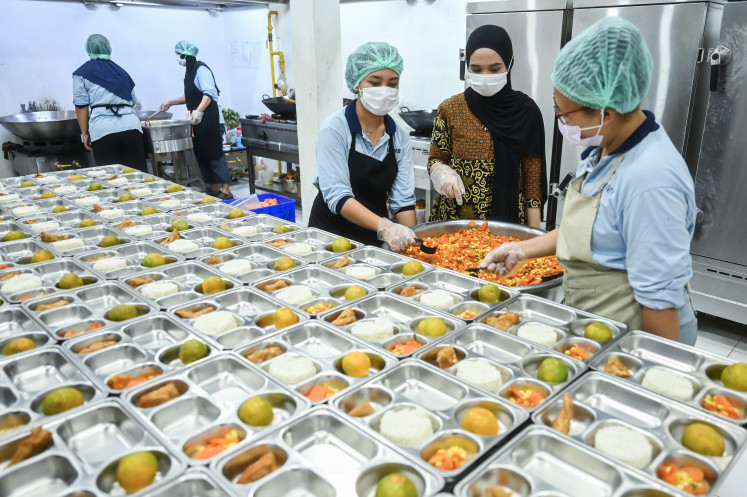Popular Reads
Top Results
Can't find what you're looking for?
View all search resultsPopular Reads
Top Results
Can't find what you're looking for?
View all search resultsPastor Robert Ramone: Introducing Sumba through photographs
JP/Enos Bulu BaliApart from his duties as a pastor, what Robert Ramone loves most is photography
Change text size
Gift Premium Articles
to Anyone

J
span class="caption" style="width: 398px;">JP/Enos Bulu BaliApart from his duties as a pastor, what Robert Ramone loves most is photography.
It began 19 years ago, when he began to aim his pocket camera at beautiful objects — mostly flowers — just for fun.
At the time, film was still used for photography. “As the film and its processing were expensive, I had to scrimp and save to take pictures. Moreover, there wasn’t much money in the seminary for the pastime,” said the Catholic priest from Sumba, East Nusa Tenggara (NTT).
He later turned to more serious objects, and he became known as a cultural photographer. He went to villages and cultural events with traditionally clad dancers beside communal houses and megalith tombs. It is not easy to find dancers in traditional dress in Sumba because regional dance performances are very ceremonial and usually involve costly rituals.
Father Robert has so far produced tens of thousands of pictures, in print as well as computer files. Postcards bearing his photographs have even reached Germany and the Netherlands.
And now his hobby has born fruit. Along with 23 other recipients, Father Robert was granted the Cultural Award by the Culture and Tourism Ministry.
In Sumba dress — minus a dagger, which was held by security guards at the entrance of the Jakarta Convention Center where he was honored — Robert received the prize from Vice President Boediono. “I hope Sumba will be better known. Sumba’s popularity is far more important to me than my own fame,” he said.
He said this because for him Sumba is lagging in many respects. “While other regions, such as in Java, are making great strides, Sumba has remained static. This amounts to being abandoned and forgotten,” the writer of Sumba, Forgotten Island said.
His book of photographs, printed in the Netherlands and widely circulated there, should also have been distributed in Indonesia. Sadly, 320 copies of the book are still being held by the Tanjung Priok Port customs agency. In order to have them released, Robert was asked to pay a substantial fee. “I don’t have that much,” he said.
Before his ministerial award, in Kupang, Timor, on Dec. 18, 2010, Robert also received the NTT Academia Award. NTT intellectuals working all over the world who organized the presentation praised Robert for his preservation of the nation’s culture through photography.
Robert expressed his concern over the lack of cultural awareness among most youth in Sumba. “They should recognize their culture because they are growing with it. Their identity is Sumba, with its noble values of how to maintain relationships with God, nature and fellow human beings,” he said.
According to Robert, a community is identified through its culture. “How can the people of Sumba be identifiable if they are not rooted in or aware of their own culture?” he asked. He referred to katoda, or totems, which can be found in villages as icons of authority. The cultural symbols that have survived for centuries in Sumba are places of agricultural offerings and expressions of gratitude for the blessings of their ancestors.
It is believed that unless this is observed, a disaster or harvest failure might occur due to the wrath of the ancestors. “We don’t consider it superstition. But the practice is supposed to teach us the wisdom of feeling grateful for what we’ve gained,” he said.
But, the younger generation deems katoda meaningless. “If this representation is meaningless, which one is meaningful — just show me!” he said.
Robert initiated the establishment of the Institute for Sumba Cultural Preservation and Studies (LSPBS) with the consent and support of his congregation as well as financial support from various parties. His acquaintance with Yori Antar, a leader of Han Awal Architect, led Robert to his meeting with Lisa Tirto Utomo, chairwoman of PT Aqua Golden Mississippi, a mineral water company. Lisa also owns the Tirto Utomo Foundation, which is engaged in educational and cultural preservation initiatives.
Lisa provided assistance totaling Rp 1.7 billion (US$190,000). Robert also received Rp 100 million from the Southwest Sumba regency, Rp 25 million from the West Sumba regency and Rp 50 million from the provincial administration. His own congregation, Redemptorist Indonesia, contributed Rp 100 million. “Thank God, after Bu Lisa’s assistance, several other circles came with their aid. We are very much obliged for the support,” he said.
Construction costs for the building reached Rp 1.8 billion, excluding the price of land, which belongs to Robert’s congregation. All structures have cogon-grass roofs in typical Sumba architecture.
The institute will later conduct research to synthesize ideas connected with Sumba’s indigenous culture. To this end, Robert will set up networks in various areas with historic or cultural sites. Young men fluent in local languages will be selected to assist.
Researchers will visit various sites and document their experiences in photos and videos. This would include recording folk tales connected with certain places and tribes and motivating locals to revive art such as carving pillars, woven head-cloths and ritual dances. There are also plans to organize regular workshops led by cultural experts.
Robert is determined to make the institute “a center for cultural studies and pastoral works in preaching the Gospel through local customs and traditions”, said the pastor, who was born in Kodi, Southwest Sumba, on Aug. 29, 1962.
He affirmed that LSPBS would be a partner in building a better Sumba. “We are well aware that Sumba tourism management cannot be handled by one party alone. All of us should join hands.”
To ensure smooth LSPBS research activity, his congregation has sent some of its clergymen to study anthropology and other humanities.
“This is an ambitious dream, but we wish to go on in our spirit and love of developing Sumba, especially in preserving its culture and introducing Sumba to the outside world. We have big ideas but we don’t have enough money,” Robert said.









